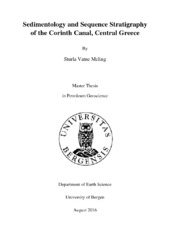Sedimentology and Sequence Stratigraphy of the Corinth Canal, central Greece
Master thesis
Permanent lenke
https://hdl.handle.net/1956/12782Utgivelsesdato
2016-08-15Metadata
Vis full innførselSamlinger
- Department of Earth Science [1050]
Sammendrag
The following study investigate the sedimentology and sequence stratigraphy of the deposits exposed in the Corinth Canal in central Greece. Earlier studies of the Canal have been focused around the uppermost part of the Canal with minor detail paid to the deposits termed the Corinth Marls". The aim of this study is to create a Tectono-Stratigraphic evolution of the deposits in the Corinth Canal. The Corinth Canal features intra-rift deposits with lacustrine to marine depositional environments, changing from foreshore to offshore environments. The Corinth Canal deposits are divided into six Tectono-Stratigraphic Units, separated by major unconformities with basinward or landward shifts in facies. Tectono-Stratigraphic Units 1 to 3 are deposited within a fluvial-lacustrine basin which is capped by a major flooding surface. Tectono-Stratigraphic Units 4 to 6 are deposited within a marine environment, featuring several transgressive events cut off by falls in relative sea level. The Corinth Canals sedimentary rocks are deposited during five Glacio-Eustatic highstands and one Glacio-Eustatic lowstand. Tectono-Stratigraphic Units 4 to 6 are deposited during five low-frequency eustatic highstand cycles (100 000 years), with deposition of the lacustrine derived Tectono-Stratigraphic Units 1 to 3 during a Glacio-Eustatic lowstand. The Tectono-Stratigraphic evolution of the Corinth Canal deposits are interpreted as lacustrine lowstand deposits overlain by five low-frequency cycles of marine deposition during the last 620 000 years. The stratigraphic packages and bounding surfaces identified within the Corinth Canal outcrops are linked with the offshore deposits of several close by basins such as the Lechaion Gulf, the Alkyonides Gulf and the Gulf of Corinth. These correlations indicate that the Tectono-Stratigraphic evolution of the Corinth Canal deposits are closely linked with the Tectono-Stratigraphic evolution of other basins within the Corinth Rift.
